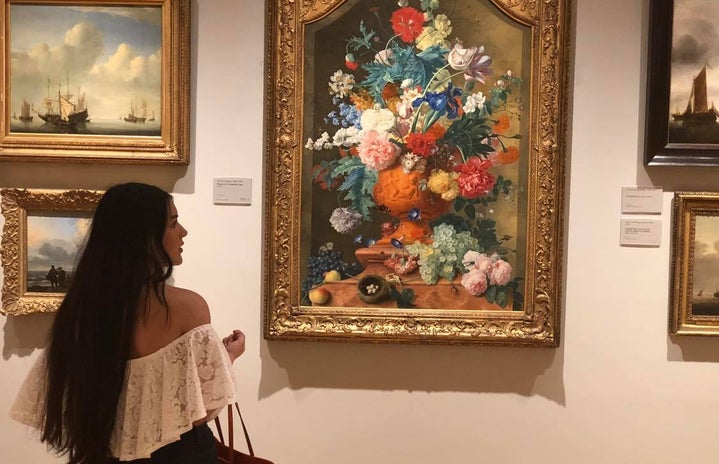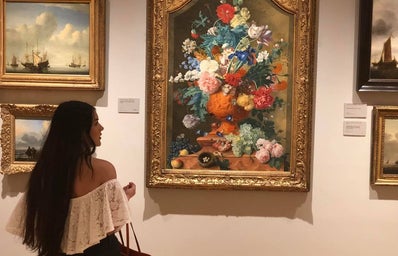The National Gallery is an art museum that stands proudly at the heart of Trafalgar Square, London. It houses a collection of 2,300 European paintings from the mid 13th century to the early 1900’s by various artists ranging from Titian to Van Gogh. The gallery was first opened to the public in the year of 1824 and has been open ever since. Entry to the gallery is free of cost however, exhibitions that are hosted from time to time are ticketed. To ensure visitor’s safety during the covid-19 pandemic, the gallery allows only a certain number of people at a time so that social distancing is maintained and the possibility of queues are reduced, you can book tickets for your visit here.
Now let’s get to my favourite paintings at the gallery!
- The Arnolfini Portrait by Jan van Eyck
-
I find this portrait exciting because there are a lot of disagreements as to what it stands for – a wedding, a memorial or that it is simply a double portrait. Most people aren’t even sure if that’s Arnolfini.
But, what we know for sure is that the man depicted in the picture is an Italian merchant who worked in Bruges and he was quite wealthy, indicators of his wealth can be seen throughout the portrait, it can be thought that the portrait is actually about his wealth.
The merchant is wearing a fur coat and his wife is wearing a long robe while it is actually summer and the tree outside the window has oranges growing on it, it is believed that one of the main sources of the Arnolfini’s wealth was by exporting oranges.
It is important to note that the period in which this painting was made – the 1400’s – a lot of emphasis was put on symbolism. In this portrait, we can see that both the merchant and his wife’s shoes are off – indicative of them engaging in a religious act, if you look all the way up towards the chandelier, there’s only one candle that’s lit which could be a reference to god’s presence.
It was common to have dogs depicted in couple’s portraits because dogs are a symbol of fidelity and loyalty. When you look closely at the mirror situated below the chandelier, you can see the reflection of visitors who are probably witnessing an event of importance taking place.
The text above the mirror reads ‘Johannes van Eyck fut hic’ which transaltes to Jan van Eyck was here, hinting at the presence of the artist whilst this was happening.
Personally, I find Jan van Eyck’s attention to detail extremely fascinating, the roundels on the mirror depict scenes from the passion of Christ and although they’re miniature, you can still figure out what’s actually going on, there are rumors that these scenes depicted in the roundels were painted with a single-haired paintbrush!
A common misconception that people have at first glance is to think that the woman in the painting is pregnant, whereas in reality, she’s not, she’s holding up her robe in a way that gives her body that rounded shape.
- Samson and Delilah by Peter Paul Rubens
-
This painting stands out to me because of the classic themes of the tragedy of love and betrayal. Samson was a Hebrew hero known for fighting the Philistines, he fell in love with Delilah who was bribed by the Philistines, he tells her that his supernatural strength comes from his uncut locks.
In this painting we can see Samson asleep on Delilah’s lap, Delilah has her clothes on but her breasts exposed. The man snipping off Samson’s hair has his hands crossed which is a symbol of betrayal, the Philistine soldiers are waiting at the door to capture Samson.
On the top left side of the painting you can see Venus the goddess of love with her son Cupid, whose mouth is bound instead of his eyes due to the surrounding episode that is unfolding. The profile of the old withered woman behind Delilah is thought to be Delilah’s future – paying for her evil deeds.
An interesting fact about this painting is that there are two prelimnary sketches of it that still exist- one in America and another in Amsterdam.
- A young woman standing at a virginal by Johannes Vermeer
-
This canvas depicts a young woman standing near a keyboard instrument, waiting for someone as the seat is left empty. The young woman is wearing an opulent dress with a blue corset and yellow puff sleeves decorated with beads, her hair put up into a bun with some curls hanging loose across her forehead. Now, moving on to the room, the floor this young woman stands on is blue and white marble tiles which indicate that it is the home of a wealthy person.
There are two paintings in the background – a landscape in a gilded frame and cupid – the god of erotic love holding up a card, the latter being a symbol of love and fidelity to a singular person. The young woman is seen looking away from these paintings, perhaps waiting for someone, but it also seems as if she is looking directly at the observer and catching them in a moment of mystery and hush.
A fun fact about this painting is that another very similar painting – A young woman sitting at a virginal also at The National Gallery, is thought to depict a venal, mercenary approach to love as opposed to the obedient love depicted here.
- The Ambassadors by Hans Holbein the Younger
-
Undoubtedly, one of the main attractions at the National Gallery is Holbein’s The Ambassadors. This painting is captivating for it’s hidden codes and multi-layer story that it narrates. To understand this painting better, we shall divide it into 4 layers. The first layer is simple, there are two men separated by objects painted with extreme detailing and preision between them. The man on the left is believed to be French ambassador Jean De Dinteville and to his right stands Georges de Selve, French ambassador to the Vatican. They’re aged 29 (inscribed on the dagger) and 25 (inscribed on the book under his arm) respectively.
Moving on to the second layer of symbolism, this painting is highly symbolic of the age it was painted in – 1533, the renaissance. Between the men, you can see the splendour of the renaissance, the top half of the shelf, we can see celestial spheres and quadrants, representing the upper heavens and on the lower half, we can see things that belong to the earthly realm- musical instruments, a book of arithmetic and a book of hymns.
The third layer, is all about the political situation in England at the time – ‘The King’s Great Matter’. King Henry VIII wanted to divorce his wife Queen Catherine of Aragon in order to marry Anne Boleyn, but to do this England had to break it’s ties with the Catholic church and therefore anoint Henry as the head of the English church. The French ambassador and his friend were in English court to probably convince King Henry VIII to change his mind. The outcome of their efforts at the time of this painting was ultimately futile, because if you look closely at the floor, it is actually the floor at the Westminster Abbey, where Henry and Anne finally got married. These are several instances where this portrait hints at division: The ambassadors being physically seperated from each other, the arithmetic book that is kept open through a divider on a page that has division sums on it, the globe is kept upside down, the page that is visible on the book of hymns, is a hymn by Martin Luther, the posterboy of the reformation and finally, the broken loose string on the musical instrument. These are all symbols of the rupture, division and disharmony caused by the rift between England and the Catholic church.
The final layer, is the layer of spirituality. If you look at the painting from the front, you can see a big white blob on the floor. This is indeed a skull when viewed from the right side and at the right height. The skull transforms this painting into a whole new genre, a memento mori, reminding us of inevitable nature of death. The skull turns every other object in this painting into mere vanities, telling us that ultimately, we’re all going to die. Almost all objects in this painting can be seen and understood from a singular angle but the skull requires us to see it from another diagonal angle, this is Holbein’s way of telling us that we should look at life from another angle.


